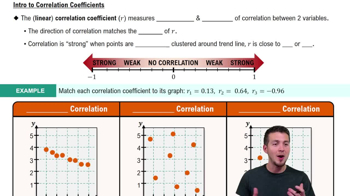Rank Correlation Use the ranks from Exercise 1 to find the value of the rank correlation coefficient. Also, use a 0.05 significance level and find the critical value of the rank correlation coefficient. What do you conclude about correlation?
Table of contents
- 1. Intro to Stats and Collecting Data1h 14m
- 2. Describing Data with Tables and Graphs1h 55m
- 3. Describing Data Numerically2h 5m
- 4. Probability2h 16m
- 5. Binomial Distribution & Discrete Random Variables3h 6m
- 6. Normal Distribution and Continuous Random Variables2h 11m
- 7. Sampling Distributions & Confidence Intervals: Mean3h 23m
- Sampling Distribution of the Sample Mean and Central Limit Theorem19m
- Distribution of Sample Mean - Excel23m
- Introduction to Confidence Intervals15m
- Confidence Intervals for Population Mean1h 18m
- Determining the Minimum Sample Size Required12m
- Finding Probabilities and T Critical Values - Excel28m
- Confidence Intervals for Population Means - Excel25m
- 8. Sampling Distributions & Confidence Intervals: Proportion1h 12m
- 9. Hypothesis Testing for One Sample3h 29m
- 10. Hypothesis Testing for Two Samples4h 50m
- Two Proportions1h 13m
- Two Proportions Hypothesis Test - Excel28m
- Two Means - Unknown, Unequal Variance1h 3m
- Two Means - Unknown Variances Hypothesis Test - Excel12m
- Two Means - Unknown, Equal Variance15m
- Two Means - Unknown, Equal Variances Hypothesis Test - Excel9m
- Two Means - Known Variance12m
- Two Means - Sigma Known Hypothesis Test - Excel21m
- Two Means - Matched Pairs (Dependent Samples)42m
- Matched Pairs Hypothesis Test - Excel12m
- 11. Correlation1h 6m
- 12. Regression1h 50m
- 13. Chi-Square Tests & Goodness of Fit1h 57m
- 14. ANOVA1h 57m
11. Correlation
Correlation Coefficient
Problem 10.1.29
Textbook Question
Appendix B Data Sets
In Exercises 29–32, use the data from Appendix B to construct a scatterplot, find the value of the linear correlation coefficient r, and find either the P-value or the critical values of r from Table A-6 using a significance level of α = 0.05. Determine whether there is sufficient evidence to support the claim of a linear correlation between the two variables.
Taxis Repeat Exercise 15 using all of the time/tip data from the 703 taxi rides listed in Data Set 32 “Taxis” from Appendix B. Compare the results to those found in Exercise 15.
 Verified step by step guidance
Verified step by step guidance1
Step 1: Extract the data for time and tip from Data Set 32 'Taxis' in Appendix B. Ensure you have all 703 data points for the analysis.
Step 2: Construct a scatterplot by plotting the time (independent variable) on the x-axis and the tip (dependent variable) on the y-axis. This will help visualize the relationship between the two variables.
Step 3: Calculate the linear correlation coefficient (r) using the formula: r = (Σ((x - x̄)(y - ȳ))) / (sqrt(Σ(x - x̄)^2) * sqrt(Σ(y - ȳ)^2)), where x̄ and ȳ are the means of the time and tip data, respectively.
Step 4: Determine the critical values of r from Table A-6 for a significance level of α = 0.05 and the appropriate degrees of freedom (df = n - 2, where n is the number of data points). Alternatively, calculate the P-value for the observed r.
Step 5: Compare the calculated r value to the critical values or the P-value to α. If |r| > critical value or P-value < α, conclude that there is sufficient evidence to support the claim of a linear correlation. Otherwise, conclude that there is insufficient evidence. Finally, compare these results to those found in Exercise 15 to identify any differences or similarities.
 Verified video answer for a similar problem:
Verified video answer for a similar problem:This video solution was recommended by our tutors as helpful for the problem above
Video duration:
3mPlay a video:
Was this helpful?
Key Concepts
Here are the essential concepts you must grasp in order to answer the question correctly.
Scatterplot
A scatterplot is a graphical representation of two variables, where each point represents an observation in the dataset. It helps visualize the relationship between the variables, indicating whether a correlation exists. The pattern of the points can suggest the strength and direction of the relationship, making it a fundamental tool in exploratory data analysis.
Recommended video:
Guided course

Scatterplots & Intro to Correlation
Linear Correlation Coefficient (r)
The linear correlation coefficient, denoted as r, quantifies the strength and direction of a linear relationship between two variables. Its value ranges from -1 to 1, where 1 indicates a perfect positive correlation, -1 indicates a perfect negative correlation, and 0 indicates no correlation. Understanding r is crucial for assessing the degree of association between the variables in the dataset.
Recommended video:
Guided course

Correlation Coefficient
P-value and Significance Level
The P-value is a statistical measure that helps determine the significance of results in hypothesis testing. It indicates the probability of observing the data, or something more extreme, if the null hypothesis is true. A significance level (α), often set at 0.05, is the threshold for deciding whether to reject the null hypothesis, providing a basis for concluding whether a linear correlation is statistically significant.
Recommended video:
Guided course

Step 3: Get P-Value

 5:43m
5:43mWatch next
Master Correlation Coefficient with a bite sized video explanation from Patrick
Start learningRelated Videos
Related Practice
Textbook Question
